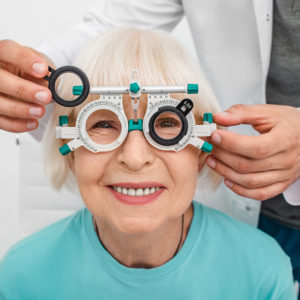May 25, 2021

Studies show that while many Americans get regular health and dental care, they may fail to have their eyes examined. Did you know that more than 23 million Americans have never had a single eye exam?
The National Eye Institute (NEI) offers these tips to protect our eyesight:
- Get an eye exam. If your eyes feel healthy, it’s easy to assume they are healthy. But getting an eye exam is the only way to be sure. Many serious eye diseases don’t have any warning signs—so you could have an eye problem and not know it. Getting an eye exam is the single best way to stay on top of your eye health!
- Know your family’s eye health history. Talking to your family members about their eye health can help you find out if you’re at higher risk for eye disease. If you learn that eye diseases run in your family, talk with your eye doctor.
- Give your eyes a rest. If you spend a lot of time at the computer, you may sometimes forget to blink—and that can tire out your eyes. To reduce eyestrain, try the 20-20-20 rule: every 20 minutes, look away from your work and focus about 20 feet in front of you for 20 seconds.
- Eat eye-healthy foods. A diet rich in a variety of fruits and vegetables—especially dark leafy greens, like spinach or kale—is important for keeping your eyes healthy. Fish high in omega-3 fatty acids—like salmon, tuna, and halibut—can also help protect your vision.
- Wear sunglasses (even on cloudy days). Sunglasses can protect your eyes from the sun’s ultraviolet (UV) rays, and help keep your eyes healthy and your vision sharp. When shopping for shades, look for a pair that blocks out at least 99% of both UVA and UVB radiation.
A family history of eye disease isn’t the only risk factor for eye diseases such as cataract, glaucoma, diabetic retinopathy and age-related macular degeneration. The top risk factor, as you might guess, is age. Today 8.2 million seniors in America are living with visual impairment, and according to a recent projection by researchers from the University of Southern California’s Roski Eye Institute, that number will double to 16.4 million over the next 35 years.
The study authors reported, “People who are visually impaired or blind can suffer both physical and mental health decline, including an increased risk for chronic health conditions such as diabetes; unintended injuries including a higher risk for falls; social isolation and withdrawal from activities that require driving or independent mobility; depression; and even death.”
Vision loss is also costly to our society. The USC research team, led by Dr. Rohit Varma, reported that the economic burden of vision loss makes it among the costliest conditions in the nation.
The NEI says that everyone older than 50 should have a comprehensive eye examination. Even if you are not experiencing vision problems, it’s important to have a dilated eye exam. Early detection and treatment can help save your sight.
Source: IlluminAge AgeWise, reporting on information from the National Eye Institute and the University of Southern California Roski Eye Institute.
